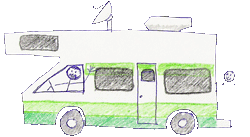




July 6, we left sunny, bright Fairbanks to drive SW 124 miles to Denali NP. This highway is one of the newest highways in Alaska and is well paved and made for fast, easy traveling. The highway passed through Spruce forests that ran along the Tanana River.
We passed through Nenana, one of the few towns on the road to Denali (pop-550). What was interesting about Nenana, is that they have a contest each year to see who can predict when the ice will break up on the Tanana River. They set up a tripod in the middle of the river that trips a line, and then stops a clock the moment the ice starts moving. Anyone can register a guess (even tourists) and a cash prize is awarded for the winner ($300,000 in 1996)
We pulled into Denali NP, picked up our camping reservation, and headed 13 miles into the park to Savage River CG. This is the only reservation that we made in advance, because it is such a popular place and difficult to get into. Riley Creek campground is located close to the entrance of the park and has 146 sites. The campground has sites in the trees and is quite nice, but we preferred to be away from the crowds and noise and more in tune with nature.
Savage River CG has only 33 sites and we picked a site on the edge of the Spruce forest with a view of the Alaska Range to the south and Mt. McKinley to the west. Mt. McKinley is usually covered in clouds, but we were able to see it most days, but usually for only a few hours. It’s 20,320 ft high and covered in snow and glaciers all year long. It is a majestic mountain. The mountain was approximately 50 miles to the west from the CG. The park does not offer the best viewing of the mountain, you actually get better views from the south as you approach Denali.
Denali is VERY popular, and there are the lots of tourists, campers, and tours (especially add ons from the cruise lines). Cars are only allowed to drive 15 miles into the park and then the rest of the park can only be seen on NP buses that require a reservation. The buses (school bus variety) leave every 30 min. and offer a variety of tours ranging from 4-11 hrs. We took one of the tours 8 yrs. ago, and we look forward to doing it again when we return to Denali later in this trip.
The park offers shuttle buses to every destination that run every 30 min., and there is limited parking available for personal cars. It’s too bad that more national parks don’t use this system, because it has really cut down on the traffic. Once you leave the visitor’s center area there is very little traffic (you are truly one with nature).
We spent our time hiking (it did take one of us a day or so to work up the courage after all the bear warnings, the photo shows us hiking the Savage River), attending park ranger programs, checking out the visitor’s center and sled dog kennels (only National Park with sled dogs), reading, etc.
They have a massive warning and awareness program about the dangers of the wildlife. Wolves frequent the area (one was seen in our CG and one CG was closed because of wolf activity), as do moose. Moose are very protective of their young and will charge and can kick. We saw a moose sow and babies along side of the road. No grizzlies yet, but most of them are deeper into the park.
The warnings say: don’t run from a grizzle or a wolf (they will think you are prey) but run from a moose. If a grizzle charges and makes contact with you, play dead, and if it eats on you too much, fight back. DUH.
Denali NP is very large and covers over 9,000 sq. miles. It has a variety of terrain with mountains, rivers, lakes, tundra, and taiga (spruce forests with dwarf birch and willow shrubs). Much of the ground has permafrost (permanently frozen ground under a layer of top soil).
The weather was very changeable- sunny during the day with off and on showers (usually in the afternoon and evenings) and highs in the 60’s and lows in the 40’s-50’s. We still got about 20 hrs of sunlight, but being in the forest and having some cloudy skies made for darker sleeping.





























